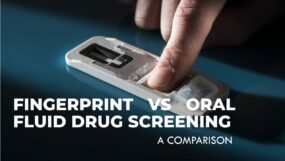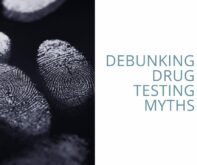Simplifying drug testing for construction firms
04.02.2022

Simplifying drug testing for construction firms
By Josh Klein-Davies, Intelligent Fingerprinting
Josh joined Intelligent Fingerprinting in 2020, and is account manager for a growing number of well-known brands in the construction, manufacturing and transport & logistics sectors. In this blog, Josh outlines his experiences of how the UK’s leading construction market is reacting to our innovative, fingerprint-based Drug Testing System, and also highlights some of the features and capabilities that are resonating with UK organisations.
________________
Drug Testing in the Construction Industry
Drug testing in the construction industry has a key role to play in discouraging and identifying drug use amongst employees, particularly as the onus is on employers to maintain a safe workplace. Since joining Intelligent Fingerprinting I’ve found that this is particularly important in construction, where any kind of employee impairment is worrying – not just for staff, but also for a firm’s customers and the wider general public.
According to the latest report[1] from the European Monitoring Centre for Drugs and Drug Addiction, cannabis use among young UK adults aged 15-34 was 13.4% in 2018, while cocaine usage in the same group was at 5.3%. Research[2] we commissioned in 2018 supports these stats, suggesting that more than one in ten workers across the UK has suspected a colleague of taking illegal drugs, with that figure rising to 24% in London.
The UK’s figures aren’t the highest usage rate in Europe, but they do show just how widespread drug misuse is and raise concerns when it comes to health and safety in the workplace.
In a high-risk environment such as a construction site, there’s clearly a requirement for firms to deliver on their corporate responsibility obligations. There are also potentially serious consequences for failing to do this, with the Misuse of Drugs Act making it an offence for managers to knowingly allow the taking of drugs on workplace premises.
A New Way To Test
Because fingerprint drug testing is quick and easy to deploy – unlike traditional urine or saliva-based tests that can be invasive, time-consuming and undignified for everyone involved – our new approach is certainly attracting attention from construction businesses. And because our portable drug screening system supports all forms of employee drug testing – from pre-employment screens and random drug tests to post-accident investigations – construction firms are finding that fingerprint-based drug tests provide a cost-effective and practical way of supporting their health and safety initiatives and enabling their drug misuse policies.
Keepmoat Homes Case Study
One forward-thinking organisation that’s already taking advantage of fingerprint drug testing is Keepmoat Homes, one of the UK’s top 10 builders of high-quality homes. They have started to use fingerprint drug testing across their 100 UK construction sites to manage risk in the area of safety-critical plant operations. Testing includes building site plant operators – both employees and contractors – who operate safety critical machinery on the company’s building sites, including cranes, diggers, dumpers, and telehandlers.
Selecting The Most Appropriate Drug Testing Method
Like other workplace drug testing organisations, construction firms have to think carefully about selecting the drug test method that best meets the requirements set out in their drug policy. For example, while some employers have a zero-tolerance approach towards drug taking by employees at any time, other companies consider their employees’ leisure activities their own business, so long as they are fit for duty when they arrive at work. However, different drug testing methods provide different ‘windows of detection’, so employers need to choose the best approach to support their drug misuse policy. Some methods will indicate very recent drug use – such as just before an employee starts their shift – while others will detect use several days ago – such as at the weekend – even though the employee is no longer under the influence of the drug when they come to work.
Urine-based tests offer a longer window of detection, which means an employee could screen positive and possibly be suspended from work as a result of drug use a few days earlier, despite being fit for duty at the time of the test. Of course, any positive screening result should always be verified with a laboratory confirmation test.
In contrast, fingerprint-based testing, with its shorter window of detection, is proving particularly helpful for drug testing in the construction sector. It gives firms a quick yet dignified way of identifying potential employee drug use in the period immediately prior to their working shift, helping them to meet their Health and Safety at Work obligations while also supporting their duty of care towards employees.
Keepmoat Homes was particularly impressed by the Intelligent Fingerprinting system’s shorter window of detection that – at around 16 hours – provides a quick and dignified way of identifying potential drug misuse in the period immediately prior to the test. A positive result indicates recent drug use, and therefore suggests a greater risk of impairment at the time of test. This approach aligns with TUC guidance on drug testing in the workplace.
More Information
Got any questions? Contact me to find out how fingerprint drug testing could bring new levels of convenience, speed and dignity to drug testing within your organisation, or contact us for further information.
References:
- European Monitoring Centre for Drugs and Drug Addiction (EMCDDA): European Drug Report: Trends and Developments, June 2021
- Research commissioned by Intelligent Fingerprinting, carried out by Opinion Matters, April 2018, 1,200 respondents



